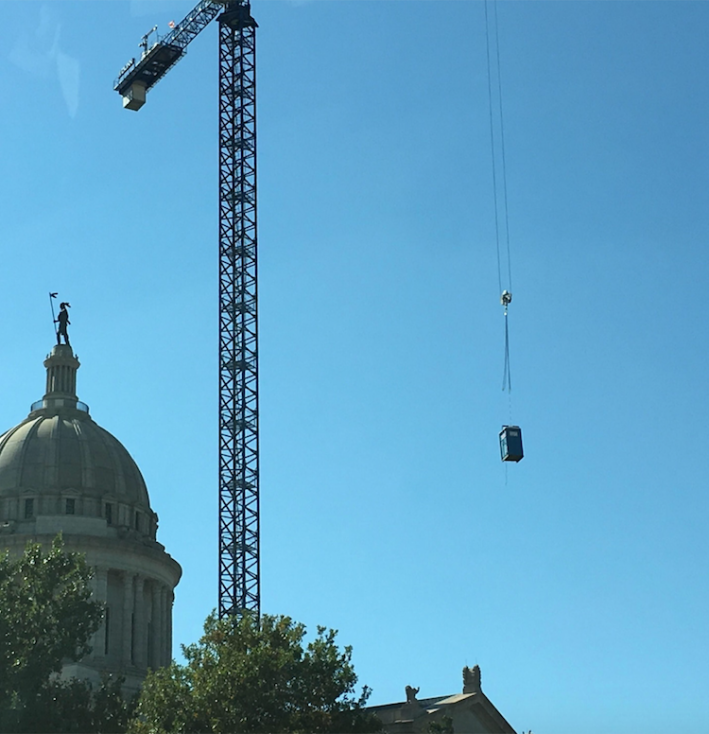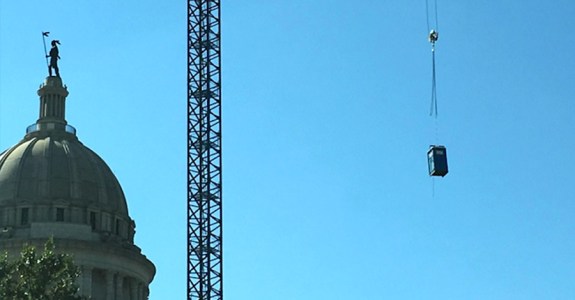On a sunny day outside the Oklahoma capitol, a massive tower crane lifted a symbol of what some say is a true waste of taxpayer dollars – a portable toilet.

As it was hoisted to a new location amid the construction, onlookers snapped a photograph that would be shared throughout the capitol, causing lawmakers, elected officials and people who really need to go to the bathroom wonder why such an expensive piece of construction equipment was needed at all.
According to records from the Office of Management and Enterprise services, the crane is costing taxpayers $1.1-million. That includes the cost of the operator of the crane at $227,020.
However, any casual observer of the capitol construction would note the crane, when it isn’t lifting portable toilets, goes unused on most days.
It makes one wonder the purpose of the crane. Is it being kept around as a symbol of Oklahoma growth, or do lawmakers have it on stand by to assist in the construction of the next American Ninja Warrior obstacle course?
We asked Shelly Zumwalt, the spokesperson for OMES, to explain:
“The state does not maintain records of usage for any equipment on the jobsite,” Zumwalt told The Lost Ogle. “The crane is an essential piece of equipment for completion of the roofing project and is used as often as needed by the design-build team.”
Not so says many lawmakers. They referred us to construction equipment leasing companies and the Oklahoma State Capitol Architect and Curator Duane Mass.
“I did not support the tower crane,” Mass said.
Mass, a historical preservationist architect with experience working on multi-million dollar projects, said much smaller cranes have been used in the past to make roof repairs. Without going into detail on the type of crane he would recommend for the project, he said a million-dollar tower crane was nowhere in his recommendation.
A smaller crane, known as a “crawler” crane was suggested as a possible alternative by sources at the capitol with construction experience. OMES said a smaller crane would cost more in the long run because it would need to be deconstructed and moved. In addition, Zumwalt said the smaller crane needs 260 feet of space to operate and that amount of space is not available on any side of the capitol grounds.
“That seems like a lot of space,” an Oklahoma City crane rental company told me.
The equipment rental company provided information about crane options that could be used for the five-story capitol building but asked we not use their name for fear of repercussions.
Depending on the size of the crawler crane, it could cost around $5,000 a day to operate (including the operator costs) for a project on a building the size of the Oklahoma Capitol, but admitted it would be extra work to deconstruct and move a smaller crane around the capitol building, though the crane company estimated time to move a smaller crane in terms of hours rather than the days estimated by OMES.
Mass said his original suggestion had the roof project as the last part to finish at the capitol because of the fragile copper roof used on the roof. He would not wade into the issue of the type of smaller crane that could be used, but said he wrote a letter to project leaders detailing why he believed the tower crane was an unnecessary expense.
Besides the crane, capitol insiders say the capitol project has wasted taxpayer money by sending project leaders on trips to other states to observe other capitol renovation projects.
Atop the Nebraska State Capitol earlier today. pic.twitter.com/65Mg9wWgaF
— Trait Thompson (@TraitThompson) September 22, 2015
Taxpayers have footed the bill for trips to Kansas, Minnesota, Nebraska and Arkansas for project leader Trait Thompson. Governor Mary Fallin appointed the former member of her campaign staff to run the capitol restoration project.
While Thompson’s total reimbursements for travel have totaled less than $3,000, critics argue the project was for the Oklahoma capitol and, as it happens, there is no other Oklahoma capitol building anywhere else in the world.
“In each instance of visiting other capitols, I have learned information and gained relationships that have been helpful to me in my role as project manager and to our project team. I viewed these trips as a reasonable expense to learn valuable information about a project the likes of which had not been executed in our state’s history. I consider our success in executing the project thus far to be partly due to the solid groundwork of knowledge we gained on these trips early on,” Thompson said in response to questions about the out-of-state trips.
Thompson said he has made other trips at his own expense to better understand the scope of the work needed to restore and maintain the capitol building.
The capitol renovation project began with a $120-million price tag, but that has expanded. The state now estimates that once the final bill is tallied it could end up costing $260-million to fix the problems caused by decades of neglect to the people’s building.
Phil Cross is an award-winning investigative journalist and is now a reporter for hire with an eye on Oklahoma’s government, crime and corruption. You can find Phil on Twitter @philsnews.
=








